Ferguson
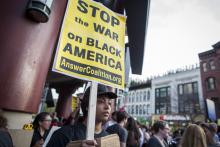
Baltimore, like Ferguson, is a parable — a story that can teach us important lessons. It's one in which we should see that we are, for the most part, still missing the most important lessons.
Decades of bad behavior on the part of Baltimore's police force in relation to the black community were brought to light, as in other circumstances of young black men dying at the hands of police. But the parable of Baltimore needs to go deeper.
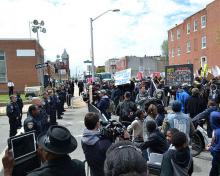
Perhaps we are here again because we do not really listen. We gaze at each other’s pain and lament, but we don’t really see in a way that will shift our vision, clarify our perspective. We hear each other’s stories but don’t really listen in a way that will change us in a profound way, lead us to question our deepest held assumptions. We post a hashtag but don’t embody these digital signatures in our everyday lives?

I walked through ash and glass as neighbors and community members swept up the remnants of our neighborhood. The night before, flames touched sky in all corners of our city as news and police helicopters hovered overhead. The city was Los Angeles. The year was 1992, and it was the third day after the police who beat Rodney King were acquitted by an overwhelmingly white jury in Simi Valley.
That was the day I was introduced to the words of Jeremiah 29:7: “But seek the peace of the city where I have sent you into exile, and pray to the Lord on its behalf, for in its peace you will find your peace.”
On Monday, Maryland Gov. Larry Hogan called in the National Guard and Baltimore Mayor Stephanie Rawlings-Blake declared a citywide curfew to quell violence that erupted in Monument City following the funeral of 25-year-old Freddie Gray. Gray died a week after sustaining a nearly severed spinal cord after being detained by police on April 12. The reason for the stop? Gray ran after making eye contact with police. An investigation is ongoing — while the people of Baltimore and beyond demand justice.
The images of fires rising over the Baltimore landscape were eerie, as it was only a few months ago that the nation sat glued to television sets watching the small town of Ferguson, Mo., erupt. And I fear we are becoming numb to it. We turn the TV on to watch our favorite reality show. We see chanting, running black people, and we think: again? Then we turn back to The Voice.
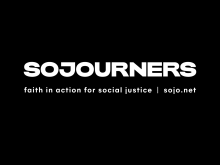
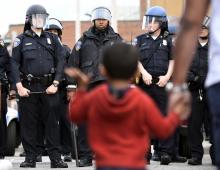
I enjoy cop shows on television.
My favorite is Blue Bloods, following the “Reagan” family from terrorist threats to homicides to domestic violence.
I can’t imagine what it’s like to be a cop. Perhaps routine marked by bursts of frenzy, some of it life-threatening. One’s hometown seen through the lens of crime, tragedy, and evil. Low pay, high risk.
I like Blue Bloods because it shows upright law enforcement taking “Protect and Serve” seriously and making brave and ethical choices.
These shows are quite unrealistic, of course. Crime doesn’t get solved that easily or snap decisions made that wisely.
I don’t think, however, that I realized until recently how separated from reality those fictional accounts have been. As police shootings of unarmed citizens go viral, as minorities talk of long-standing police brutality, as we watch guards beating prisoners, and as federal law enforcement engages in creepy surveillance, internal corruption, and the arming of local police as military commandos, the veil is lifted.
Now we see in our own American law enforcement the same brutality and power-madness that have marked corrupt societies we supposedly surpassed, from the secret police in Eastern Europe to uniformed thugs in South America.
I find it confusing. Not the discovery that TV isn’t real, but to see how low we have fallen. Has this brutality been the dark side of police work all along?
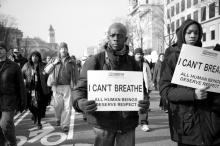
In “A Newsfeed of Fear” (Sojourners, May 2015), Gareth Higgins argues that our newsfeeds often scare us into believing the world is getting worse when the world is actually getting better.
Although I resonate with a call for calm in an age of violent clickbait, we cannot discuss “A Newsfeed of Fear” without talking about race in post-Ferguson America. When we say our newsfeeds are filled with fear, we need to think more about which newsfeeds are making us afraid and whose fear we’re discussing.
For example, when Higgins bemoans “horrifying, brutal videos, edited for maximum sinister impact,” perhaps a reference to the all-too-familiar videos of ISIS hostages, I actually envision Walter Scott and Eric Garner and Tamir Rice and all the others. While the videos produced by ISIS are fearmongering propaganda intended to provoke, we wouldn’t want to call newsfeeds unmasking the reality of police brutality a corrupting influence on our society, right?
And in this context Higgins’ claim that the world is actually getting better is especially dangerous. Advising police brutality whistle blowers to keep their violent videos to themselves because they paint “too cynical a portrait of the improved race-relations in our society” would border on the insane.
The problem with media is not so much that it makes us fearful, but that it makes certain people fear certainthings and certain other kinds of people. It makes my mom fear that her granddaughters will get kidnapped in a very safe neighborhood. It makes me, a white guy, fear walking past black men in hoodies at night, and not white guys in polos. What you fear depends on where you’re standing and what you’re watching.
From where Higgins is standing, “our culture has been hoodwinked by the idea that we’re living in the center of crisis, when actually we’re in the midst of the evolution of hope.” In his eyes, our culture cultivates a false sense of constant terror.
But we need to ask: whose culture? When I read #BlackLivesMatter activists, they seem to say: “no, most people have been hoodwinked by the idea that ‘our’ (meaning American) culture is living in the midst of the evolution of hope, when actually ‘a certain (black) culture’ is indeed in the center of crisis.” So who’s right about the value of violent, fearful newsfeeds?
It depends on where you’re standing and what you’re watching.
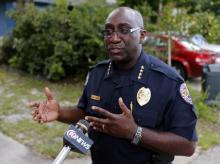
Christian ministers should establish relationships with law enforcement, seek ways to become moral authorities in their communities, and listen.
Those were the top recommendations from experts at a panel sponsored by The Gospel Coalition on April 14 titled “Seeking Justice and Mercy From Ferguson to New York.”
The popular ministry offered an alternative approach to that of evangelist Franklin Graham, who was widely criticized for his recent “Obey the police, or else” comments on Facebook. The comments followed the spate of police killings of unarmed black men.
In response to that Facebook post, 31 African-American, Hispanic and Asian-American leaders, many of them evangelicals, signed an open letter to Graham, saying he revealed a lack of empathy and understanding of the justice system.
At the April 14 panel, pastor and former public defender Ed Copeland; music producer and Filipino film and TV actor Alex Medina; Sanford, Fla., Police Chief Cecil Smith; and U.S. Attorney Robert Lang offered tips to help ministers and other church leaders become “ministers of reconciliation.”

We call it Holy Week. But it was a terrible week.
His trial reeked of injustice. His own disciple sold him out for a few pieces of silver, betrayed him with a kiss … and hung himself.
As he was arrested, one of his closest friends disregarded all his teaching on love, pulled out a knife, and cut a guy’s ear off. (Jesus called him out … and healed the other guy). A lot of the stuff that happened that first holy week was pretty unholy.
Once arrested, he was passed back and forth between politicians and bureaucrats. There was Caiaphas the priest, the Sanhedrin council, Pontius Pilate, the crowd — everyone seemed to want him dead, but no one wanted blood on their hands. Even Pilate washed his clean.
They had all kinds of accusations. Insurrection. Inciting a riot. Conspiracy. Terrorism (plotting to destroy the temple). Blasphemy.
But all he did was love. And heal. And give people hope.
Despite any substantial evidence, witnesses, or signs of any crime committed, he was pronounced guilty and sentenced to die.
As he awaited his fate, he was bullied, interrogated, harassed, tortured, beaten to a pulp. The authorities humiliated him and stripped him naked. They mocked the claims of his divinity, ramming a crown of thorns onto his head and wrapping him in a royal purple robe as they laughed.
And so it went. This man who many believe was the holy one that the prophets spoke of, the long-awaited Messiah, God incarnate, love with skin on— was executed, brutally. He died with his body convulsing as his lungs collapsed, with vultures swarming overhead, hoping to clean up after the execution. There is nothing more evil than what happened that “Good” Friday.

We don’t know what prompted Rev. Franklin Graham to log onto Facebook and pound out the words that lit a firestorm last week. But within one day, tens of thousands of his faithful followers liked and shared his short, patronizing post that called “Blacks, Whites, Latinos, and everybody else” to “Listen up” and tune in to his take on why so many black people have died at the hands of police officers recently. According to Graham, the problem is “simple.” It can be reduced to their lack of obedience and bad parenting.
By Monday morning, more than 80,000 people shared the post and almost 200,000 liked it. Sojourners’ Jim Wallis penned a strong response.
On Friday an evangelical pastor based in Oakland, Calif. (the birthplace of the Black Lives Matter movement), Dominique Gilliard, shared the post with a small diverse group of evangelical leaders who decided to craft a collective response. This open letter was crafted by the collective efforts of Rev. Leroy Barber (CCDA and Word Made Flesh), Gilliard (New Hope Oakland), Dr. Brian Bantum (Seattle Pacific University), Micky ScottBey Jones (Transform Network), Efrem Smith (World Impact) and me (Sojourners). We didn’t know if our words would resonate. We only knew the truth that we must speak in response to Graham’s outsized influence coupled with apparent ignorance. In the end, a broad representation of national evangelical leaders agreed to sign this letter to Graham as principal signatories.
We invite you to read it, discuss it in your churches, and add your name to the many who say “No more!” We will not tolerate this type of flippant, patronizing commentary from faith leaders on critical issues that mean life and death for many in the body of Christ and in communities across America. We won’t tolerate it, even one more day. Rather, we invite all with open hearts to enter into dialogue — and to join us in the ministry of the gospel — the ministry of reconciliation.
While statistics, tweets, marches, and articles can bolster and enliven movements, art brings in the endurance. Art makes injustice a song that gets stuck in your head. Art makes murals out of obituaries, and hope out of statistics. Below, check out some of the art surrounding the Black Lives Matter movement:
1. Epitaph as protest. In “All Eyes Are Upon Us” (Sojourners April 2015) Gene Grabiner references 14 fallen people of color—men, women, and children, from 1973 to 2014—all casualties of “this war against the people.”
2. Nightmares. In her spoken word poem “black. anathema.”Jessica Edwards mourns the feared death of her unborn black child: “My soul mourning you prematurely, / clutching my empty womb bitterly.”

Lent is our season of honesty. It is a time when we may break out of our illusions to face the reality of our life in preparation for Easter, a radical new beginning.
When, through this illusion-breaking homework, we connect with reality, we see that in our society the fabric of human community is almost totally broken. One glaring evidence of such brokenness is the current unrelieved tension between police and citizens in Ferguson, Missouri.
That tension is rooted in very old racism. It also reflects the deep and growing gap between “the ownership class” that employs the police and those who have no serious access to ownership who become victims of legalized violence.
This is one frontal manifestation of “the covenant that they broke,” as referred to in the Jeremiah text for this week: a refusal of neighborly solidarity that leads, with seeming certitude, to disastrous social consequences.
Of course the issue is not limited to Ferguson but is massively systemic in U.S. society. The brokenness consists not so much in the actual street violence perpetrated in that unequal contest. The brokenness is that such brutalizing force is accepted as conventional, necessary, and routine. It is a policy and a practice of violence acted out as “ordinary” that indicates a complete failure of neighborly imagination.
Lent is a time for honesty that may disrupt the illusion of well-being that is fostered by the advocates of indulgent privilege and strident exceptionalism that disregards the facts on the ground. Against such ideological self-sufficiency, the prophetic tradition speaks of the brokenness of the covenant that makes healthy life possible.
As long as there is denial and illusion, nothing genuinely new can happen. But when reality is faced — in this case the reality of a failed covenant between legal power and vulnerable citizens — new possibility becomes imaginable.
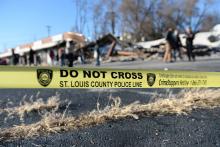
Early Thursday morning, just hours after the resignation of Ferguson police Chief Thomas Jackson, two officers were shot as they stood guard amidst protests outside the police department in Ferguson, Mo. One officer, a 41-year old from the St. Louis County Police Department, was struck in the shoulder. The other, a 32-year old from nearby Webster Groves Police Department, was hit in the face. Both officers were reported to be in serious, but non-life threatening condition.
As local authorities search for the unidentified shooters, protesters and police have begun to speculate about causes and responsibility.

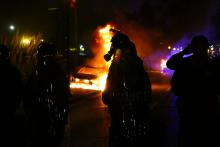
“Some of those protestors were right,” said Attorney General Eric Holder, as he released the Justice Department’s report on the police department in Ferguson, Mo. The report should be read by anyone who believes in racial justice and reconciliation, because it shows us what we are still up against in 2015, 50 years after the Selma march. This is not a post-racial America, especially in regard to our policing and criminal justice systems. Ferguson has become a teaching parable for the nation.
After a detailed and thorough investigation over many months, the devastating report revealed a police force and court system in Ferguson that proves true virtually everything young protestors and local residents have been saying since the shooting of Michael Brown last August.
The Ferguson Police Department replaced its mission of public protection with revenue generation by extracting money from the black residents of their town, using methods that the Justice Department said “may be unlawful.” The report painfully and painstakingly reveals unconstitutional and consistently abusive policing aimed at balancing the city budget on the backs of its poorest and black citizens. The Ferguson police went beyond even racial profiling to direct racist exploitation for a profit, with police apparently more concerned about “ fill[ing] the revenue pipeline” than protecting public safety. The use of traffic stops, citations, court appearances, fines, and even arrests that were specifically targeted at black residents revealed a profound contempt for black people with racial slurs and abuse a daily occurrence. Disgusting racist jokes, even aimed at the president and the first lady, circulated in e-mails from police supervisors and court officials. One joked about a black mother getting a crime prevention award for having an abortion.

The zeitgeist is clear. Much like Emmett Till’s murder in 1955 sparked the civil rights movement, the tragic string of murders of blacks in 2014 catalyzed another movement, the #BlackLivesMatter movement. This movement picks up where the civil rights movement left off, addressing systemic racial injustice in the legal and penal system, educational system, and economic system. In some ways, the battles we fight are more challenging than the ones our grandparents fought. Undeniably, we face off in a more complex world and against forms of systemic racism that are so subtle that they are almost invisible. Nevertheless, due to a unique combination of gifts and experiences, I’m hopeful that my generation of black millennials is ready to lead us on to a more equitable society. Here’s why.
1. We are propelled by the prophetic legacy of the past.
With a technological savvy that gives us unprecedented access to the true history of our people, and as perhaps the last generation to breathe the same air as the civil rights generation, we draw upon the legacies of the past as we move forward. When I sense that my capacity to forgive is waning, I recall my recent conversations with several survivors of the 16th Street Baptist Church bombing in Birmingham, Ala., and I’m reminded of the inner healing that forgiveness promises. When I am tempted to pander to the powers that be, I call my radical granddad and ask him to tell me again about the many Black Panthers meetings that took place at the church he pastored in Berkeley, Calif., in the 1960s. When I feel that I’m losing my courage, I read Ida B. Wells’ autobiography and am reminded that we are not alone. We are connected — part of a chain of black activists, each generation inspiring the next. Our heroes guide us every day.
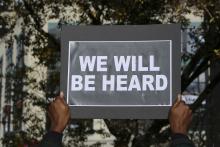
I cringed. Recently, I sat watching a cable news broadcast — can’t remember which one. What I do remember is it featured people doing good in the world … and it made me cringe.
Lots of people were highlighted, but the two young black people they featured both shared the same general narrative: So and so had a hard life. He came from poverty. She came from abuse or neglect. But they rose above. Now look at all they’ve accomplished. It was striking. None of the stories of white people started with this narrative. Rather, theirs usually went something like: Little Suzy or Johnny took a class project and turned it into a major non-profit that helps thousands of orphans … in Africa.
No matter where you tuned into this broadcast, blackness unconsciously was associated with hardship and overcoming while whiteness was associated with genius and compassion.
I sat there thinking: The truth is we have had centuries of hardship to press through. Our history is present, the good and the bad. As in Toni Morrison’s Beloved, the ghost of slavery haunts us. It affects our present. But it’s not just the past that haunts us. It is the same basic oppression of yesteryear —confinement, control, and disregard for black lives. So, it makes sense that the stories of our overcomers are as potent in current-day narratives as they are in history.
Jackie Robinson, Joe Lewis, Paul Robeson, Zora Neale Hurston, Billie Holiday, were the overcomers of our past. The black children in that broadcast were the overcomers of our present.
But what about the black future? One hundred years from now, will my family’s descendants still have to watch featured stories of black people doing good that always begins: So and so had a hard life?
During Black History Month we typically look back on all the accomplishments of those who paved the road for generations to come. But this month, we have been inspired by the #BlackLivesMatter movement to look forward to another kind of future for black men, women, and children.

On Feb. 8, civil rights attorneys sued the city of Ferguson, Mo ., over the practice of jailing people for failure to pay fines for traffic tickets and other minor, non-criminal offenses.
And to this I say: It’s about time.
Growing up with an attorney father — a “yellow dog Democrat” one at that — who often took on poor clients in return for yard work and other non-cash payments, I heard early and often about the unfair — and illegal — practice of debtors’ prison. A poor person could not be jailed for failure to pay a fine, my father told me. I trusted his words were true.
So imagine my surprise when at the age of 18, I was arrested for unpaid traffic fines.
At that time I was a stay-at-home mom, trapped in a too-early marriage I would one day leave. My son was probably 6 months old. When the knock came at my door and I saw a police officer standing outside, I didn’t hesitate to answer.
The officer confirmed my identity and told me I was under arrest for failure to pay traffic tickets I had received for driving an unregistered vehicle.
I know that I should have paid the registration. Once ticketed, I know I should have worked out a payment plan. I know I should have taken responsibility for my illegal actions.
But I was young, inexperienced with the system, and very, very poor. Too poor to keep up with even the most modest of payment plans.

Sparked by the shooting death of Mike Brown in Ferguson, the subsequent deaths at the hands of law enforcement of Eric Garner in New York and 12 year-old Tamir Rice in Cleveland, protests under the banners of #ferguson, #icantbreathe, and #blacklivesmatter have spread around the country and a passionate conversation about the role of race in America has been rejoined. These protests, along with coverage by news media and the voices of social commentators and faith leaders — as well as the well-timed critical success of the movie Selma — have moved matters of race to the fore of our cultural consciousness and conversation in a way rarely seen since the Civil Rights movement of the 1950’s and 1960’s.
And yet, despite this heightened awareness about the experience of people of color, there remains a great distance and disconnect between white and minority communities regarding not only the actions of law enforcement, but also the varied manifestations of systemic and institutional racism. Indeed, the very real troubles experienced by communities of color are largely invisible to many whites. In Ferguson itself, many whites prior to the death of Mike Brown reported being unaware of the tension between African-American community and law enforcement. Nationwide, whites and African-Americans had very different perspectives. Whereas 80 percent of African Americans said Mike Brown’s shooting raised issues about race, only 37 percent of whites said the same.
In a time when renewed engagement is desperately needed, it is difficult to have dialogue when a vast majority of whites cannot empathize with the experience of communities of color, or, in some cases, acknowledge that there is a problem at all.


National Guard Sgt. Valerie Deant found mugshots of black men, including one of her brother, riddled with bullet holes at a police range in south Florida last month. After outraged critics drew attention to the police department, clergy across the country began to post photos of their own faces with the hashtag #UseMeInstead. The Washington Post explains why the hashtag began:
The effort was “motivated by our service to Christ and his call to love our neighbors,” Gonnerman told The Post.
“We initially started thinking if a whole lot of us, in our clergy collar and worship attire, sent our photos to them, it would make a really powerful statement,” Rev. Kris Totzke, a pastor in Texas, told The Post. “Then, it really snowballed, and we got people all over the country and of all different faiths.” …
“It’s such a desensitization thing, that if you start aiming at young black men, and told to put a bullet in them, you become desensitized,” Gonnerman said. “Maybe, to change the picture, it’s you know what, dare ya, shoot a clergy person.”